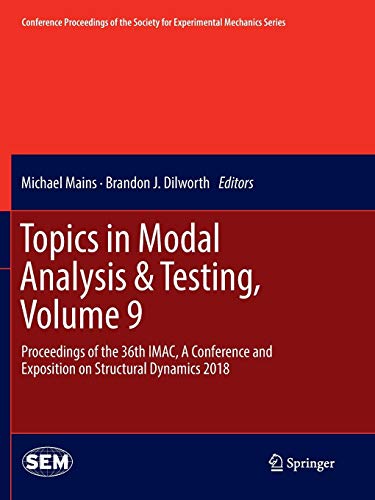图书简介
Topics in Modal Analysis & Testing, Volume 9: Proceedings of the 36th IMAC, A Conference and Exposition on Structural Dynamics, 2018, the ninth volume of nine from the Conference, brings together contributions to this important area of research and engineering. The collection presents early findings and case studies on fundamental and applied aspects of Modal Analysis, including papers on: Operational Modal & Modal Analysis Applications Experimental Techniques Modal Analysis, Measurements & Parameter Estimation Modal Vectors & Modeling Basics of Modal Analysis Additive Manufacturing & Modal Testing of Printed Parts
Chapter 1. Stochastic Modal Appropriation (SMA).- Chapter 2. Derivation of Six Degree of Freedom Shaker Inputs Using Sub-Structuring Techniques.- Chapter 3. Forced Response of 2-Dof Gyroscopic Systems with Stable Eigenvalues.- Chapter 4. Modal Testing of a Composite Bladed Disc Using Travelling Wave Excitation Method. -Chapter 5. Simulation of the Dynamic Behavior of a Bi-cable Ropeway with Modal Bases.- Chapter 6. Influence of Noise in Correlation Function Estimates for Operational Modal Analysis.- Chapter 7. Comparison of two (Geometric) Algorithms for Auto OMA.- Chapter 8. Operational Modal Analysis On Wind Turbine Hub.- Chapter 9. The Influence of Edge Boundary Conditions and Cracks on Vibrational Modes of Multilayer Ceramic Capacitors.- Chapter 10. The Cross Spectrum in Multiple Input Multiple Response Vibration Testing.- Chapter 11. A Systematic Evaluation of Test Specification Derivation Methods for Multi-Axis Vibration Testing.- Chapter 12. Designing Hardware for the Boundary Condition Round Robin Challenge.- Chapter 13. Modal Comparison of Stock and Performance Brake Rotors.- Chapter 14. On the Veering Phenomenon Potential in High Speed Gears Design.- Chapter 15. Modal Truncation in Experimental Modal Analysis.- Chapter 16. Combined Mechanical Environments for Design and Qualification.- Chapter 17. Comparing Free-Free and Shaker Table Model Correlation Methods Using Jim Beam. Chapter 18. Realtime Hybrid Testing: Challenges and Experiences from a Teaching Point of View.- Chapter 19. Comparison of Computational Generalized and Standard Eigenvalue Solutions of Rotating Systems. -Chapter 20. Residual States for Modal Models Identified from Accelerance Data.- Chapter 21. Comparison of Time-Domain Objective Functions in Dynamic Fixture Optimization.- Chapter 22. Advanced Hammer Excitation Technique for Impact Modal Testing on Lightweight Materials using Scalable Automatic Modal Hammer.- Chapter 23. Evaluation of MIMO Input Derivations and their Physical Context.- Chapter 24. Using Modal Substructuring to Improve Shock & Vibration Qualification.- Chapter 25. Off-Axis Input Characterization of Random Vibration Laboratory Data for Model Credibility.- Chapter 26. Modal Analysis of a Brake-Ruess Beam and Computational Modeling at the Undergraduate Level.- Chapter 27. A Primer on Multiple Degree of Freedom Vibration Test for Aerospace and Military Applications.- Chapter 28. A Study on the Generation and Propagation of Traveling Waves in Strings.- Chapter 29. A Colored Complex Mode Indicator Function for Selecting a Final Mode Set.- Chapter 30. Using Manual Excitation for Large Displacement on a Highly Damped System.- Chapter 31. Traveling Wave Generation on a Clamped, Thin Plate with Flush-mounted Piezoelectric Actuators.- Chapter 32. Experimental Modal Analysis of an Aircraft Fuselage Panel - Part II.- Chapter 33. Combining Virtual Simulation with Hands-on Experiments for Teaching Mechanical Vibration.- Chapter 34. Finite Element Model Updating Using the Local Correspondence Principle.- Chapter 35. Approximate General Responses of Tuned and Mistuned 4-Degree-of-Freedom Systems with Parametric Stiffness.- Chapter 36. Modal Analysis of a Vertical-axis Darrieus Wind Turbine Blade with a Troposkein Shape.- Chapter 37. Floquet-Type Analysis of Transient Vibrations of a Horizontal Axis Wind Turbine.- Chapter 38. Evaluation of Traveling Wave Models for Carangiform Swimming Based on Complex Modes.- Chapter 39. Application of Frequency-Domain Decomposition Identification Technique to Half Spectral Densities.- Chapter 40. Modal Survey of the MPCV Orion European Service Module Structural Test Article using a Multi-Axis Shaker Table.- Chapter 41. Modal Analysis of Healthy and Cracked Isotropic Plates in Peridynamics.- Chapter 42. Initial Modal Results and Operating Data Acquisition of Shock/Vibration Fixture.- Chapter 43. Effects of Variable Thickness Circular Plates on Frequency Response Functions and Shock Response Spectrum.- Chapter 44. Inverse Force Estimation for Resonant Shock Plate Application.
Trade Policy 买家须知
- 关于产品:
- ● 正版保障:本网站隶属于中国国际图书贸易集团公司,确保所有图书都是100%正版。
- ● 环保纸张:进口图书大多使用的都是环保轻型张,颜色偏黄,重量比较轻。
- ● 毛边版:即书翻页的地方,故意做成了参差不齐的样子,一般为精装版,更具收藏价值。
关于退换货:- 由于预订产品的特殊性,采购订单正式发订后,买方不得无故取消全部或部分产品的订购。
- 由于进口图书的特殊性,发生以下情况的,请直接拒收货物,由快递返回:
- ● 外包装破损/发错货/少发货/图书外观破损/图书配件不全(例如:光盘等)
并请在工作日通过电话400-008-1110联系我们。
- 签收后,如发生以下情况,请在签收后的5个工作日内联系客服办理退换货:
- ● 缺页/错页/错印/脱线
关于发货时间:- 一般情况下:
- ●【现货】 下单后48小时内由北京(库房)发出快递。
- ●【预订】【预售】下单后国外发货,到货时间预计5-8周左右,店铺默认中通快递,如需顺丰快递邮费到付。
- ● 需要开具发票的客户,发货时间可能在上述基础上再延后1-2个工作日(紧急发票需求,请联系010-68433105/3213);
- ● 如遇其他特殊原因,对发货时间有影响的,我们会第一时间在网站公告,敬请留意。
关于到货时间:- 由于进口图书入境入库后,都是委托第三方快递发货,所以我们只能保证在规定时间内发出,但无法为您保证确切的到货时间。
- ● 主要城市一般2-4天
- ● 偏远地区一般4-7天
关于接听咨询电话的时间:- 010-68433105/3213正常接听咨询电话的时间为:周一至周五上午8:30~下午5:00,周六、日及法定节假日休息,将无法接听来电,敬请谅解。
- 其它时间您也可以通过邮件联系我们:customer@readgo.cn,工作日会优先处理。
关于快递:- ● 已付款订单:主要由中通、宅急送负责派送,订单进度查询请拨打010-68433105/3213。
本书暂无推荐
本书暂无推荐















